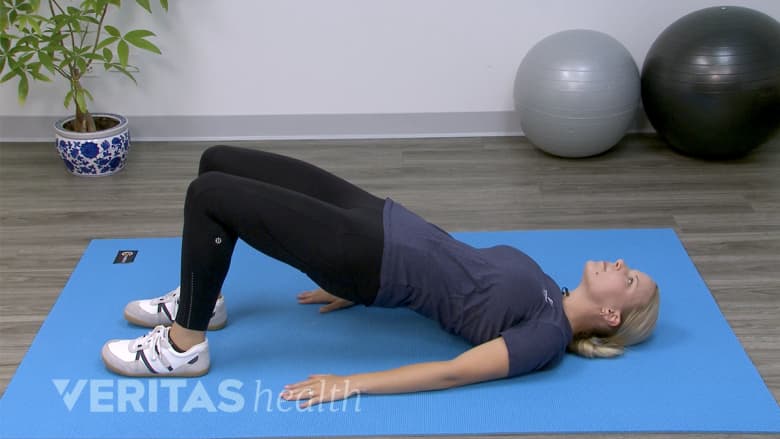Once a doctor determines that weight loss is necessary, the patient then prepares to embark on a lifestyle-altering program of physical activity and diet to achieve the target weight. Another goal may be the general feeling of well-being that arises from a new lifestyle of healthy eating and regular exercise.
Practical guidelines that comprise a sustainable exercise program are outlined below.
In This Article:
- Weight Loss for Back Pain Relief
- Weight Loss and Exercise for Patients
- Nutrition and Diet for Weight Loss
Beginning a Safe Weight Loss Program
Before starting any weight loss program, it is important to ensure that the program is safe by meeting with a health care professional. A safe weight loss program takes into account any existing back conditions and symptoms.
Beginning the weight loss program with gentle, low-impact exercises, such as walking or water therapy, help ease back into regular physical activity, without overstressing or straining muscles or joints.
Initial pain and discomfort can be expected as the body adjusts to the exercise component of the program. Any severe pain, discomfort, or major change in symptoms during the program needs to be reported to the medical professional monitoring the patient’s condition.
The Best Exercise Programs to Lose Weight and Relieve Back Pain

The prone press exercise relieves back pain, enhances flexibility, and strengthens the core.
Research suggests that some exercise programs are more effective than others in assisting with weight loss, reducing chronic low back pain, and improving the quality of life and functional ability.1Wasser JG, Vasilopoulos T, Zdziarski LA, Vincent HK. Exercise Benefits for Chronic Low Back Pain in Overweight and Obese Individuals. PM R. 2017;9(2):181-192. doi:10.1016/j.pmrj.2016.06.019
The most beneficial types of exercise include:
- Resistance exercise. Two types of resistance exercises include total body resistance exercise, which strengthens the body’s major muscle groups, and lumbar extension exercise, which focuses on the lower back. Total body resistance exercise more effectively improves perceived disability (how disabled the individual views himself or herself to be) than lumbar extension exercise.2Vincent HK, George SZ, Seay AN, Vincent KR, Hurley RW. Resistance exercise, disability, and pain catastrophizing in obese adults with back pain. Med Sci Sports Exerc. 2014;46(9):1693-1701. doi:10.1249/MSS.0000000000000294 Examples of resistance exercises that do not require weights or resistance bands include squats, push-ups, sit-ups, and prone press-ups.
- Aquatic exercise. Exercises that would normally be too painful to do on land are often tolerable to do in water. The buoyancy of water counteracts gravity, supports the extra body weight, allows free movement, and provides friction against movement. Strengthening and conditioning exercises can easily be performed in water with a reduced risk of losing balance and causing further injury.1Wasser JG, Vasilopoulos T, Zdziarski LA, Vincent HK. Exercise Benefits for Chronic Low Back Pain in Overweight and Obese Individuals. PM R. 2017;9(2):181-192. doi:10.1016/j.pmrj.2016.06.019
Pilates also improves low back pain related to excess weight,3Valenza MC, Rodríguez-Torres J, Cabrera-Martos I, Díaz-Pelegrina A, Aguilar-Ferrándiz ME, Castellote-Caballero Y. Results of a Pilates exercise program in patients with chronic non-specific low back pain: a randomized controlled trial. Clin Rehabil. 2017;31(6):753-760. doi:10.1177/0269215516651978 but individuals who are overweight and obese tend to commit more easily to resistance and aquatic exercises.2Vincent HK, George SZ, Seay AN, Vincent KR, Hurley RW. Resistance exercise, disability, and pain catastrophizing in obese adults with back pain. Med Sci Sports Exerc. 2014;46(9):1693-1701. doi:10.1249/MSS.0000000000000294
See Pilates Exercise and Back Pain
How Exercise and Weight Loss Help the Back

Regular exercise helps relieve back pain from excess weight.
Excess weight and lack of exercise may cause or aggravate back pain. A regular and sustained exercise program can help alleviate episodes of back pain and prevent (or minimize) recurrence of pain.
Movement and exercise:
- Foster blood flow, which helps distribute nutrients into the disc space and soft tissues in and around the spine
- Provide more pain relief than bed rest and inactivity
- Train the muscles to move in a specific pattern that will be protective of the spine both during the exercise and while doing other daily activities
Exchange of nutrients through exercise keeps the discs, muscles, ligaments, and joints in the back healthy.
See 5 Nutrients to Support Healing from Back Pain and Back Surgery
Patients tend to overprotect the back and avoid exercise after experiencing pain or having back surgery. Without sufficient exercise, the supporting structures in the back may become stiff, weak, and deconditioned over time. Lack of conditioning results in a vicious cycle: increased back pain leads to more inactivity, in turn leading to more intense back pain.
Get started with an Easy Exercise Program for Low Back Pain Relief
Barriers to Keeping the Weight Down
After achieving weight loss, the body’s metabolic balance is offset. Naturally, the body tries to maintain homeostasis (equilibrium) and regain the lost weight.
The challenge to keep the weight down typically involves one of more of these 3 obstacles4Melby CL, Paris HL, Foright RM, Peth J. Attenuating the Biologic Drive for Weight Regain Following Weight Loss: Must What Goes Down Always Go Back Up?. Nutrients. 2017;9(5):468. Published 2017 May 6. doi:10.3390/nu9050468:
- Less energy is used. Day-to-day activities may be less physiologically demanding after weight loss. For example, climbing a staircase requires less effort and less energy than before.
- Hormones fluctuate. The hormone leptin inhibits hunger and is part of a negative feedback loop that regulates weight.5Friedman JM. The function of leptin in nutrition, weight, and physiology. Nutr Rev. 2002;60(10 Pt 2):S1-87. doi:10.1301/002966402320634878 Loss of weight leads to a decrease in leptin, and consequently an increase in appetite.
- The thermic effect of food decreases. Specific dynamic action and thermic effect of food are both terms that refer to the increase in metabolic rate just after eating. Digesting and processing a meal require energy, and the amount of energy depends on the type and quantity of food consumed.
Slow and steady lifestyle changes can help overcome these barriers, rather than sudden changes that require drastic adjustment. Specific measures to effectively maintain weight loss include:
- Exercise more frequently. If exercise helped decrease the weight, then it is increasingly important to continue the exercise routine. Moderate to high levels of activity, for 2.5 hours or more per week, are associated with successful weight maintenance.6Melby CL, Paris HL, Foright RM, Peth J. Attenuating the Biologic Drive for Weight Regain Following Weight Loss: Must What Goes Down Always Go Back Up?. Nutrients. 2017;9(5):468. Published 2017 May 6. doi:10.3390/nu9050468,7Melby CL, Paris HL, Sayer RD, Bell C, Hill JO. Increasing Energy Flux to Maintain Diet-Induced Weight Loss. Nutrients. 2019;11(10):2533. Published 2019 Oct 21. doi:10.3390/nu11102533,8Knell G, Li Q, Morales-Marroquin E, Drope J, Gabriel KP, Shuval K. Physical Activity, Sleep, and Sedentary Behavior among Successful Long-Term Weight Loss Maintainers: Findings from a U.S. National Study. Int J Environ Res Public Health. 2021;18(11):5557. Published 2021 May 22. doi:10.3390/ijerph18115557 Research suggests that the best exercise program includes both strength and endurance exercises.9Rojo-Tirado MA, Benito PJ, Ruiz JR, et al. Body Composition Changes after a Weight Loss Intervention: A 3-Year Follow-Up Study. Nutrients. 2021;13(1):164. Published 2021 Jan 7. doi:10.3390/nu13010164
- Lose weight slowly. It is advisable to lose no more than 0.5 to 1 pound per week, and to keep the weight constant for about 6 months following every 5 to 10% decrease in body weight. An interval of weight maintenance helps the body adapt to its new metabolic requirements and prevents a rapid return to the original weight.
- Eat a plant-based diet. One way to increase the thermic effect of food is to eat unprocessed plants such as fruits, vegetables, beans, and nuts. Fat and carbohydrates are easier to process than protein, so it is important to choose foods that are lean sources of protein and low on the glycemic index.10Calcagno M, Kahleova H, Alwarith J, et al. The Thermic Effect of Food: A Review. J Am Coll Nutr. 2019;38(6):547-551. doi:10.1080/07315724.2018.1552544
Moderate to vigorous physical activity and diet-controlled weight loss are achievable ways to effectively reduce back pain connected to excess weight.11Mendonça CR, Noll M, Rodrigues APDS, Vitorino PVO, Mendes MA, Silveira EA. Association of Pain, Severe Pain, and Multisite Pain with the Level of Physical Activity and Sedentary Behavior in Severely Obese Adults: Baseline Data from the DieTBra Trial. Int J Environ Res Public Health. 2020;17(12):4478. Published 2020 Jun 22. doi:10.3390/ijerph17124478,12Dunlevy C, MacLellan GA, O'Malley E, et al. Does changing weight change pain? Retrospective data analysis from a national multidisciplinary weight management service. Eur J Pain. 2019;23(8):1403-1415. doi:10.1002/ejp.1397 While these measures are effective for most individuals, metabolic disorders pose a greater challenge to weight loss for back pain relief and demand supplemental measures. Individuals with insulin resistance or type 2 diabetes may find additional treatments or foods, such as pomegranate, helpful in regulating metabolism.
- 1 Wasser JG, Vasilopoulos T, Zdziarski LA, Vincent HK. Exercise Benefits for Chronic Low Back Pain in Overweight and Obese Individuals. PM R. 2017;9(2):181-192. doi:10.1016/j.pmrj.2016.06.019
- 2 Vincent HK, George SZ, Seay AN, Vincent KR, Hurley RW. Resistance exercise, disability, and pain catastrophizing in obese adults with back pain. Med Sci Sports Exerc. 2014;46(9):1693-1701. doi:10.1249/MSS.0000000000000294
- 3 Valenza MC, Rodríguez-Torres J, Cabrera-Martos I, Díaz-Pelegrina A, Aguilar-Ferrándiz ME, Castellote-Caballero Y. Results of a Pilates exercise program in patients with chronic non-specific low back pain: a randomized controlled trial. Clin Rehabil. 2017;31(6):753-760. doi:10.1177/0269215516651978
- 4 Melby CL, Paris HL, Foright RM, Peth J. Attenuating the Biologic Drive for Weight Regain Following Weight Loss: Must What Goes Down Always Go Back Up?. Nutrients. 2017;9(5):468. Published 2017 May 6. doi:10.3390/nu9050468
- 5 Friedman JM. The function of leptin in nutrition, weight, and physiology. Nutr Rev. 2002;60(10 Pt 2):S1-87. doi:10.1301/002966402320634878
- 7 Melby CL, Paris HL, Sayer RD, Bell C, Hill JO. Increasing Energy Flux to Maintain Diet-Induced Weight Loss. Nutrients. 2019;11(10):2533. Published 2019 Oct 21. doi:10.3390/nu11102533
- 8 Knell G, Li Q, Morales-Marroquin E, Drope J, Gabriel KP, Shuval K. Physical Activity, Sleep, and Sedentary Behavior among Successful Long-Term Weight Loss Maintainers: Findings from a U.S. National Study. Int J Environ Res Public Health. 2021;18(11):5557. Published 2021 May 22. doi:10.3390/ijerph18115557
- 9 Rojo-Tirado MA, Benito PJ, Ruiz JR, et al. Body Composition Changes after a Weight Loss Intervention: A 3-Year Follow-Up Study. Nutrients. 2021;13(1):164. Published 2021 Jan 7. doi:10.3390/nu13010164
- 10 Calcagno M, Kahleova H, Alwarith J, et al. The Thermic Effect of Food: A Review. J Am Coll Nutr. 2019;38(6):547-551. doi:10.1080/07315724.2018.1552544
- 11 Mendonça CR, Noll M, Rodrigues APDS, Vitorino PVO, Mendes MA, Silveira EA. Association of Pain, Severe Pain, and Multisite Pain with the Level of Physical Activity and Sedentary Behavior in Severely Obese Adults: Baseline Data from the DieTBra Trial. Int J Environ Res Public Health. 2020;17(12):4478. Published 2020 Jun 22. doi:10.3390/ijerph17124478
- 12 Dunlevy C, MacLellan GA, O'Malley E, et al. Does changing weight change pain? Retrospective data analysis from a national multidisciplinary weight management service. Eur J Pain. 2019;23(8):1403-1415. doi:10.1002/ejp.1397

